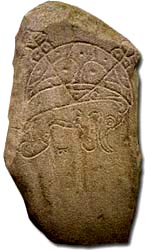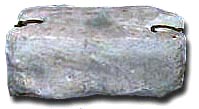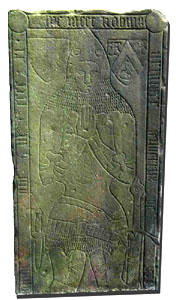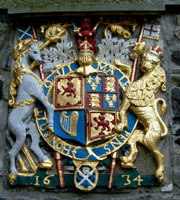|
|
| |
Scots Heraldry - The Heraldry
Society of Scotland |
. |
| |
|
|
| |
Monumental Heraldry
|
Heraldic
Heritage in Monuments - by John Duncan of Sketraw |
|
|
 |
|
1st
millennium Pictish stone |
|
It might be
said that something in the way of Monumental Heraldry started
in northern Britain in the later part of the first millennium
BC with the aboriginal Picts - whose name is actually a Roman
invention from the late third century AD. With the Z rods,
moons, deer, elephant, salmon, cauldrons, mirrors and combs,
ravens, axes and horses etc.
that they cut into standing
stones and monoliths, these ‘iron age’ Picts give us our first
true glimpse of the use of monumental symbolism in northern
Britain. Without a great deal more information, from other
sources that are unlikely to have survived, it isn't possible
to say that these inscriptions were hereditary or organized in
ways analogous to heraldry in later centuries, but it is
probably safe to say that they were used in many of the same
ways: to mark out territorial ownership, as personal
statements of identity, or as group markers of tribal identity
(though perhaps in not quite the same way as a modern clan
member's badge!) |
|
|
By 503AD the Celtic Scots had
entered northern Britain from the west and had begun to
introduce Christianity to the aboriginal Picts. From this time
on new forms of symbolism - griffins, dragons, knot work,
vines, trees, all sorts of beasts and mythical creatures -
began to be cut into new forms of monuments - monumental stone
crosses and grave slabs, perhaps for much the same reasons
that similar things were decorated heraldically in later
centuries.
The defeat of the Pict’s in
841AD by the Scots Celts and the unification of the two
peoples under Kenneth MacAlpin in 843AD saw the the ‘Stone of
Destiny’, the symbolic and metaphoric seat of power of the
Celtic Dalriadic Kings, moved to Scone in the old Pictish
kingdom, which was to become the centre of government, a real
seat of power in Scotland with the birth of a Scottish nation
of diverse peoples – a nation which continued to be diverse in
its origins and traditions, as the heraldry of later centuries
records. |
 |
|
2nd Millennium Pictish Stone |
|
showing the Celtic Religious |
|
Influence- reverse Celtic
Cross |
|
|
|
 |
|
The
'Stone of Destiny' |
|
Although there is no definite and clear start
date for heraldry as we know it today in Scotland, it had
certainly been established by the later part of the 12th
century and although growing in use, as can be seen from 12th
century seals, that growth and development was sadly poorly
documented in the remains that have come down to us.
|
|
|
|
Within a
century or so of the
establishment of heraldry in
Scotland the long struggle against English imperialism had
begun with the invasion under England's Edward II and the
start of the Wars of Independence. Things were to calm down
for a while with victory at Stirling Bridge, but it took eight
years of struggle from the crowning of Robert Bruce in 1306
until English military occupation was definitively ended at
Bannockburn.
Whatever heraldic records there
were in those times, whether in Scotland or stolen away by the
former occupying power, have long since vanished and all we
are left with are the seals and monuments. And this,
unfortunately, remains true of Scots heraldry through
medieval, Renaissance and Reformation times, as much of the
written and painted record has either gone in the flames of
unfortunate fires or was stolen away in a later English
military occupation, the one of the 1650s.
But although we lack the written
and painted records, what we do have, as we have for the Picts,
is the records of the monument in stone and, which we don't
have for the Picts, |
 |
|
Gilbet de Greenlaw |
|
Killed in the battle of
Harlaw 1411 |
|
|
 |
|
Arms of
Charles I - 1634, Banff |
|
the carvings in the much more
perishable medium of wood.
Over the coming months the aim
is to make a record in the
‘Monumental
Heraldry Gallery’ of some of our heraldic gems from
medieval, Renaissance, Reformation and Baroque times up to the
start of the statutory written record in 1672, including,
along the way monumental heraldry from elsewhere - for the aim
of the Society is to encourage the study of heraldry both
"indigenous and international" |
|
|
|
|
|
© The Heraldry Society of
Scotland last Update
27 Oct 2021
|
|
